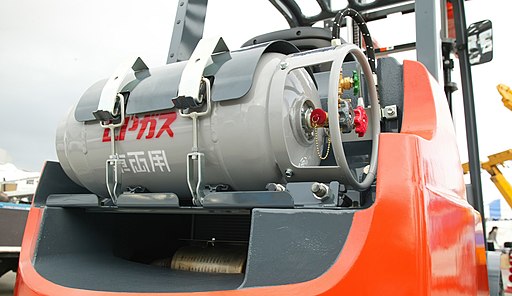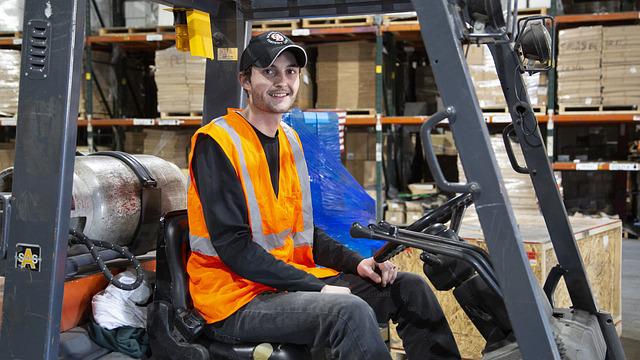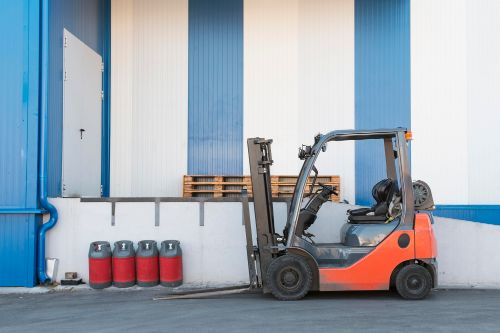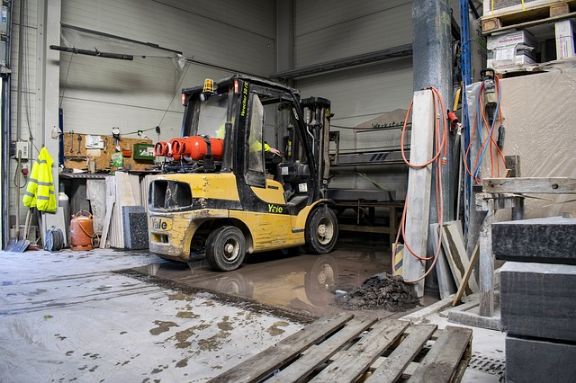
The forklift propane tank refill cost in 2024 is one of the most common queries asked by companies that use propane-powered forklifts, especially now the supply is affected by some events.
It is no secret that the cost of refilling has been increasing over time. In the year 2024, strong demand has been noticed in the past months. With the high demand comes an increase in price.
In this article, we will explore the different ways that companies can reduce the cost of refilling their tanks and save money in the process.
How Much Does It Cost to Refill a Forklift Propane Tank?
We surveyed five (5) reputable propane providers in the US market, and here’s a table to give you an estimate to refill your bottles.
| Price per Gallon | 14.5-lb (3.2 gallons) | 20-lb (4.6 gallons) | 33.5-lb (7.7-gallons) | 43-lb (10-gallons) | |
| Company A | $$2.39 | $7.64 | $10.99 | $18.40 | $23.90 |
| Company B | $3-$4 | $9.60 – $12.80 | $13.80 – $18.40 | $23.10-$30.80 | $30-$40 |
| Company C | $2.50 | $8.00 | $11.50 | $19.25 | $25.00 |
| Company D | $2.75 | $8.80 | $12.65 | $21.17 | $27.50 |
| Company E | $3.25 | $10.40 | $14.95 | $25.02 | $32.50 |
We did not specify the name of the providers we surveyed to protect their reputations. Besides, prices may go up or down in no time depending on a variety of factors, so prices of these companies may change without prior notice especially this year 2024, a lot of issues are going on that have a direct impact on the price of propane in the world market.
Read related article: Forklift Propane Tank Exchange (Cost, Where to Fill These Cylinders)
Prices Vary Widely
The amount you have to pay to refill a forklift’s propane tank can vary widely. It all depends on the factors listed below. There is no one average cost for a propane tank refill. You can find some places that charge as little as $2.39 per gallon to refill a tank.
You can also find places that charge up to $4 per gallon or more. To get an idea of how much it will cost to refill your tank, try calling a few different places. Ask how much they charge to refill a forklift tank.
Ask about their operating expenditure, and how they will impact the refill cost. This can help you find a ballpark figure. Doing this will help you know what to expect when you get your tank refilled.
Ways to Save Money
With the price of propane going up, companies may be looking for ways to reduce the expenses of refilling forklift tanks.
- We are not saying all, but a small number of propane providers in the market today, might not completely fill the empty tank to the required weight. They would hand down your bill for the whole 33 lb even though they would only fill it up to about 27 lb. These vendors are quite dubious. If you have a doubt, weigh your tank when it reaches your facility and see if it is the right weight. If there is a discrepancy, the next time you refill, find other providers that are more reputable.
- If your tank is still in good condition, with no flaws, rust, or corrosion, stick to refill not exchange. The price per gallon is significantly lower to refill than exchange. Imagine, if you have dozens of tanks to refill, the amount of money you can save is considerably higher.
- Find a propane provider that has a free delivery scheme – reputable companies usually offer such a scheme for businesses that have a large number of orders. If you’re one of these businesses, then arrange an agreement with your current provider for such a scheme.
- Use aluminum tanks – aluminum tanks are lighter than steel and therefore easy to handle and transport, thus, their utilization increases proficiency. Aluminum ones are less like to corrode and rust; they’re safer to handle because they don’t create a spark that could cause gas ignition.
- If budget isn’t a constraint in your business, construct a gas storage vessel and pump on site where you can refill tanks any time. This option is appropriate for those businesses that have a large demand for propane to power their forklifts. Arrange with a provider the delivery and filling of such vessel. Having such a vessel won’t disrupt the operation since the tanks can be immediately refilled on-site.
Here are some other strategies businesses can adopt to minimize these expenses and optimize their operations:
- Bulk Purchases
- Economies of Scale: Just like buying in bulk often reduces the cost per unit for many products, the same can apply to propane. Suppliers may offer discounted rates for larger quantities, translating to savings for businesses.
- Stable Pricing: Purchasing in bulk may also allow businesses to lock in prices, offering protection against short-term market fluctuations.
- Inventory Management: While bulk purchases can lead to cost savings, it’s vital to manage inventory efficiently. Overstocking can tie up capital, while understocking can lead to operational disruptions.
- Negotiating Contracts
- Long-term Agreements: Suppliers often favor stability. By committing to a long-term contract, businesses might secure better rates compared to ad-hoc purchases.
- Leverage Volume: If a business operates multiple facilities or has significant propane needs, leveraging this volume during negotiations can lead to better terms and prices.
- Stay Informed: Knowledge of market prices and trends can strengthen a business’s position during negotiations. Being well-informed allows businesses to negotiate from a position of strength.
- Regular Maintenance
- Prevent Leaks: Regularly inspecting tanks and associated equipment can detect and fix leaks, preventing wastage and associated costs.
- Fuel Efficiency: Ensuring that forklift engines are well-maintained can lead to more efficient fuel consumption. Simple actions like changing air filters and spark plugs can make a noticeable difference.
- Extend Lifespan: Periodic maintenance checks can extend the lifespan of tanks and equipment, reducing the need for replacements and associated costs.
- Alternative Suppliers
- Local Suppliers: Sometimes, smaller, local suppliers may offer competitive rates compared to larger, national chains. They might also provide more personalized service.
- Research and Due Diligence: Before switching suppliers, it’s essential to conduct thorough research. This includes checking reviews, understanding terms of service, and possibly running a trial phase.
- Diversify Supply: Depending on the size and scale of operations, businesses might consider having multiple suppliers. This strategy can serve as a hedge against supply disruptions and can also provide leverage during negotiations.
These are some of the opportunities businesses can do to bring down their expenses drastically.
Read related article: 10 Gallon Forklift Propane Tank (Specs to Know When Buying)
Strong Demands Affect Forklift Propane Prices
Forklifts that use propane are becoming increasingly popular, as they offer a more environmentally-friendly option than gas-powered forklifts.
However, the increased demand for propane-powered forklifts has driven up prices for propane, which has in turn affected the price of forklifts that use propane.
The price of propane has been on the rise in recent years, due to increased demand from both the industrial and residential sectors. The industrial sector is the biggest consumer of propane, and the forklift industry is one of the fastest-growing users of propane. In fact, the Forklift Propane Association estimates that there are now more than 100,000 propane-powered forklifts in operation in the United States.
The increased demand for propane has caused prices to increase by as much as 30 percent in some areas. This has had a direct impact on the price of forklifts that use propane, as manufacturers have had to increase prices to cover the higher cost of propane.
Despite the higher prices, propane-powered forklifts offer a number of advantages over their gas-powered counterparts. Propane is a cleaner burning fuel than gasoline, so it produces fewer emissions. Propane-powered forklifts also tend to be more fuel-efficient than gas-powered models, so they can save money on operating costs over time.
Factors That Influence Propane Tank Refill Prices
The cost of refilling a propane tank can vary significantly based on a range of factors. Understanding these variables helps businesses to anticipate changes and budget appropriately. Here’s a closer look at the critical determinants of propane refill costs:
- Seasonal Fluctuations
- Overview: Propane demand fluctuates with the seasons, impacting its market price.
- Winter Surge: Propane is commonly used for heating. Therefore, during colder months, especially in regions with harsh winters, demand often spikes leading to potential price increases.
- Agricultural Demand: In certain areas, propane is used for crop drying, which can create seasonal spikes in demand during harvest periods.
- Supply Chain Disruptions: Adverse weather conditions can disrupt propane production or transportation, causing short-term price hikes.
- Regional Variations
- Overview: The cost of propane can differ based on the region due to logistical, regulatory, and demand factors.
- Urban vs. Rural: Urban areas might benefit from economies of scale due to higher demand, potentially leading to lower prices. Conversely, transportation and delivery fees can inflate costs in remote or rural regions.
- State Regulations: Different states might have varying taxes, subsidies, or environmental regulations that influence propane prices.
- Transportation Costs: The proximity to major propane production or storage facilities can significantly affect transportation costs, thus impacting refill prices.
- Supplier Specifics
- Overview: The terms and conditions set by propane suppliers play a vital role in determining the refill cost.
- Contract Negotiations: Long-term contracts might offer stable or discounted prices. However, they can also lock businesses into rates that become unfavorable if market prices drop.
- Bulk Purchase Discounts: Suppliers often offer discounts for bulk purchases, benefiting businesses with large or frequent refill needs.
- Brand Competition: In regions with multiple propane suppliers, competition can drive prices down. Conversely, in areas dominated by a single brand, prices might be relatively high.
- Tank Size and Specifications
- Overview: The physical attributes of a propane tank can influence the refill costs, both directly and indirectly.
- Volume Pricing: Larger tanks might benefit from volume discounts. For instance, refilling a 500-gallon tank might be more cost-effective per gallon than a 20-gallon tank.
- Tank Design and Efficiency: Modern tanks with efficient design might require less frequent refills. Additionally, tanks designed for rapid refilling can reduce equipment downtime costs.
- Maintenance and Lifespan: High-quality tanks with robust build quality might have longer lifespans and require less maintenance, indirectly affecting the total cost of ownership and associated refill costs.
Propane refill costs are influenced by a myriad of factors, from seasonal demand fluctuations to supplier-specific conditions. For businesses relying heavily on propane-powered equipment, understanding these determinants is essential for effective budgeting and strategic procurement.
Hidden Costs Associated with Propane Refill
Propane refill for forklifts is an essential task to keep operations running smoothly. However, what appears to be a simple refill cost can sometimes be overshadowed by several hidden expenses. Understanding these costs is crucial for businesses to budget effectively and optimize their operations.
- Equipment Downtime
- Overview: Every minute a forklift stands still for refilling, it’s not doing the job it’s meant for. This translates into potential lost productivity and revenue.
- Factors Affecting Downtime:
- Refill location distance: The farther away the refill station, the longer the downtime.
- Refill frequency: If propane tanks deplete faster due to inefficiencies, more frequent refills are required.
- Propane supplier efficiency: Delays in the refill process can extend downtime.
- Estimating Lost Revenue: To assess the financial impact, businesses can calculate the hourly revenue generated by a forklift and multiply it by the downtime hours.
- Safety and Compliance Checks
- Overview: Safety is paramount when dealing with flammable substances like propane. Regular checks and compliance with standards often come at a cost.
- Mandatory Inspections: Tanks and associated equipment need periodic inspections to detect leaks, wear, and tear. These inspections, while ensuring safety, have associated labor and expertise costs.
- Cost of Non-compliance: Failing to meet safety standards can lead to hefty fines, legal fees, and even operational shutdowns.
- Delivery Fees
- Overview: For businesses that do not have on-site refill facilities, getting propane delivered or exchanging tanks can lead to additional charges.
- On-site Refilling: While convenient, on-site refilling might come with service charges, especially if emergency refills are required.
- Tank Exchange Services: Some providers offer a service where empty tanks are swapped for full ones. The fees for such services might be above the propane cost itself.
- Lease vs. Purchase
- Overview: Companies have the option to either lease propane tanks or buy them outright. Each option has its own set of financial implications.
- Leasing Tanks:
- Pros: Lower upfront costs, maintenance and inspection might be covered by the supplier, flexibility in upgrading or downsizing based on needs.
- Cons: Over time, cumulative leasing fees might surpass the cost of purchasing; potential for additional fees if tanks are damaged.
- Purchasing Tanks:
- Pros: Long-term cost-effective, full control over maintenance schedules, potential for resale or repurposing.
- Cons: Higher upfront costs, responsibility for maintenance and compliance rests with the owner.
While the upfront costs of propane refilling might seem straightforward, a deeper dive reveals several hidden costs. By understanding and anticipating these, businesses can make informed decisions that lead to operational efficiency and cost savings.
How to Know When You Need to Refill Your Forklift’s Propane Tank
If you run out of fuel in your forklift, you may have just run your propane tank dry. If you aren’t sure if you should get the tank refilled, you can use a few signs to decide. If you aren’t sure if you have enough fuel in your tank, check the gauge. If it’s on empty, it’s time for a refill.
If you are having issues with your forklift. If you are having problems with your forklift’s performance, it could be because you need a refill.
If you are having issues with your forklift’s fuel system. If you are having problems with the propane system on your forklift, a refill may be the solution.
If you notice an issue with your forklift’s engine. If you notice a dip in your engine performance, a refill may be the solution.
Where to Get Your Forklift’s Tank Refilled
There are a few options for where you can have your bottles and cylinders filled. The best place to do this will depend on a couple of factors.
You will want to find a place that is closest to your business. This will cut down on travel time and operating expenses. You will also want to find a place that can service your forklift.
This can help you find a place that knows what they are doing. Choose a place that has a good reputation. You can ask around in your industry to find out which place operators recommend. When you find a place, be sure to ask about their propane fill process.
You want to make sure they are doing it safely. You also want to make sure they are using quality fuel. Poor fuel can damage your forklift and affect its performance. And make sure that the tank is not expired, otherwise, the refilling station will not refill it.
How to Find a Reputable Company for Propane Refills
If you aren’t sure where to find a reputable company for propane refills, there are a few ways you can go about it. You can start by asking your forklift dealer for recommendations.
Another option is to do an online search. You can look up propane fill stations in your area. You can also look up forklift dealers in your area. Find out where they get their propane refills. This can help you find a reputable company.
You can ask your operator if they might have friends who can recommend a reputable propane provider. You can also ask them where they would recommend. You may also be able to find a reputable company online, just do a Google search. This can help you find a place that has good reviews.
FAQs
- How much propane is in a forklift tank?
- Most forklift propane tanks have a capacity of around 33 pounds (about 7.9 gallons) when filled to 80% capacity, which is the recommended fill level to allow for the expansion of the liquid propane.
- How much LPG does a forklift use per hour?
- The amount of LPG a forklift consumes per hour depends on the size and load of the forklift and the intensity of its use. On average, a forklift with a standard-sized tank might use approximately 1 to 1.5 gallons of propane per hour under typical operating conditions.
- Can you fill a propane tank on a forklift?
- Yes, you can fill a propane tank on a forklift, but it’s crucial to follow safety procedures. Make sure the forklift engine is turned off, and you’re filling the tank in a well-ventilated area. Use appropriate personal protective equipment, such as gloves and safety glasses. If you’re unfamiliar with the process, it’s best to be trained by a professional or use a propane delivery service.
- How long will a propane tank last on a forklift?
- Given the average consumption rate mentioned above (1 to 1.5 gallons per hour), a standard-sized forklift propane tank with about 7.9 gallons of propane can last roughly 5 to 8 hours of continuous operation. However, this duration can vary based on the factors like the forklift’s efficiency, the weight of the loads being carried, and how intensively the forklift is being used.
- Do forklift tanks expire?
- Yes, forklift propane tanks do have an expiration date, typically stamped on the collar of the tank. In many countries, including the U.S., propane tanks must be inspected and requalified (or replaced) every 10 years, although this timeframe can vary depending on local regulations and the specific type of tank. Always ensure that tanks are checked regularly for damage, leaks, or signs of wear, and adhere to the recommended requalification or replacement schedule.
Final Words
Navigating the intricacies of forklift propane refill costs is more than just looking at the price tag. You might see a straightforward expense on paper, but diving deeper reveals hidden costs, market dynamics, and other factors that can significantly affect your business’s financial health. It’s essential for you to grasp the full picture to maximize efficiency and achieve cost-effective operations.
In today’s fast-paced business world, resting on your laurels can come at a hefty price. Market prices fluctuate, new technologies emerge, and regulations evolve. What worked for you yesterday might not be the best strategy tomorrow. For this reason, it’s crucial for you to stay updated, reassess your strategies, and adapt as needed.
Remember, by staying proactive and committing to continuous learning, you’ll be better equipped to handle the challenges of forklift propane refill costs and ensure your operations remain both sustainable and cost-effective.

Mike is an experienced propane technician with over 15 years of professional experience in the field. He has dedicated his career to helping customers with their propane needs, from installation to maintenance and repair. Together with Jeremy, he co-founded this website to provide useful information and guidance to customers seeking reliable propane services.



